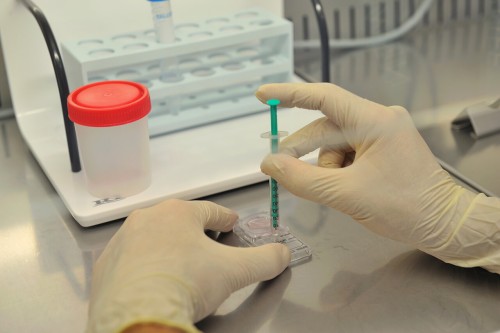DNA fragmentation and Microfluidic Sperm Sorting Device (ZyMōt®)
Advanced sperm selection techniques have been increasingly applied in fertility laboratories in an attempt to improve clinical results of Assisted Reproduction Technologies (ARTs). The optimum sperm selection method should aim to isolate exclusively motile spermatozoa with intact DNA taking into consideration numerous parameters including the cost, the DNA damage, and the useful yield.
On average only ~55% of spermatozoa in neat semen samples contain intact DNA. Under natural conditions, the millions of spermatozoa will undergo an intensive selection process to assure that only the optimum sperm will reach the oocyte. The last decades, the main sperm preparation technique has been the density gradient centrifugation (DGC), during which the spermatozoa are forced to cross a gradient column. However, increasing evidence suggest that DGC can decrease motility, and increase sperm DNA damage. Several studies have linked increased DNA damage with lower blastocyst formation rate, impaired embryo development, and increased chances for miscarriages.
Microfluidics
Alternative sperm selection techniques utilize different physicochemical characteristics (e.g., morphological, membrane, apoptotic features) in an attempt to ensure sperm genetic integrity and fertilization capacity and improve embryo development, and most importantly delivery rates.Numerous previous studies have tried to investigate, compare, and report the clinical effects of these different sperm selection techniques, however, none of them was proven to be unanimously superior. In most of the cases, little or no effect on clinical pregnancy and live birth rates was observed using different techniques.
Microfluidics is a new era in sperm selection techniques and has been reported as an alternative method of sperm preparation in an ART setting. The principle of microfluidic sperm sorting devices (ZyMōt®) is based on rheotaxis, which is the tendency of the spermatozoa to swim against the stream of fluid. This way of separation is semi-automated, faster, gentler, and, mimics -up to a point- the natural selection in uterus. At the same time, avoids the potentially toxic components and DNA damage caused by the silicon-based centrifugation step. Most importantly, the DNA fragmentation levels post microfluidic sperm preparation are nearly detectable. In terms of technical and laboratory aspect, a sample processed with ZyMōt® consists of exclusively motile spermatozoa making the sperm selection during ICSI procedure easier and safer.

Who can be benefited?
Undoubtedly, men with known high levels of sperm DNA fragmentation.Its application has also been recommended for couples with previous miscarriages, poor blastocyst formation rate, as well as in couples suffering from unexplained infertility. In the absence of a female-related infertility factor, many males present good conventional semen parameters (motility, concentration), however, they fail to conceive. Several theories have been proposed to explain male unexplained infertility. Often, in ART laboratories, where usually only the basic semen parameters are assessed, a normal sperm analysis might mask underlying problematic conditions, such increased levels of DNA fragmentation index. Indeed, 11% of normozoospermic infertile men presented increased levels of sperm DNA fragmentation.
Sperm selection is undeniably an important factor for achieving higher live birth rates in ARTs. Thus, one of the main challenges in reproductive medicine is to ensure the highest quality of the selected spermatozoa, and specifically, in terms of genetic integrity. Therefore, the known direct association between sperm progressive motility and DNA integrity persuades us to suggest ZyMōt® as the optimum way of sperm separation.









